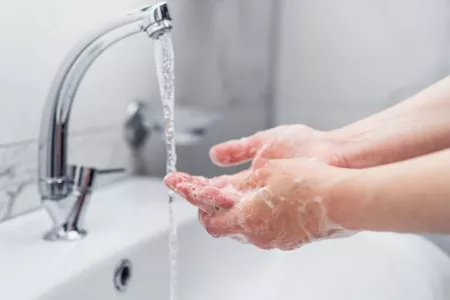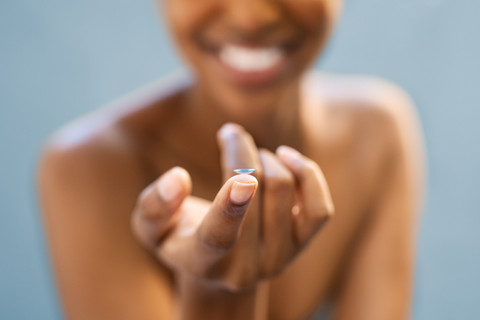Contact lenses are medical devices, and you must learn how to use them safely for your eye health. For example, you need to learn appropriate and hygienic methods of handling, cleaning, and storing your contact lenses. You also have to know how to put in contacts, take them out, and the right lens to purchase.
Contact lens etiquette describes the guidelines you must adhere to for effective and safe use of your lenses. There are several types of contact lenses, and it is essential to learn how to use each type safely. Read this guide from WebEyeCare to learn how to put in and how to take out contacts.
How to Easily Put Your Contacts in
Here’s is a step-by-step guide on how to put contacts in:
- Wash your hands thoroughly with soap and water. Maintaining good contact lens hygiene is a critical part of contact lens care. Washing your hands prevents bacteria that could cause an eye infection from getting into your eyes. Use non-perfumed soap as scented soaps may irritate your eyes
- Rinse and dry your hands with a lint-free or paper towel before you handle the lens
- Place the lens on the index finger of your dominant hand. Ensure the edges of the lens are turned up and not out
- Raise your head and look straight ahead. Pull down your lower eyelid with the little finger of the hand not holding the lens. You have to be extra careful if you have long nails
- Look up steadily at a point above you, and place the lens on the lower white part of the eye
- Remove your index finger and slowly release the lower eyelid
- Look downwards to position the lens correctly
- Close your eyes briefly to allow the lens to center. It should feel comfortable, and you should see clearly after blinking a few times
- Repeat the procedure for the other eye
How to Remove Your Contacts
You also have to know how to remove contacts safely:
- Wash, rinse, and dry your hands in the same way
- Always start with the same lens first. Ensure the lens is in the proper position before attempting to remove it. You can verify if the lens is in the correct position by closing one eye at a time
- Look up and carefully pull down your lower eyelid with your middle finger. Bring your index finger slowly to your eye until you touch the lower edge of the lens
- Squeeze the lens gently between your thumb and index finger to take it out. Avoid sticking the edges of the lens together
- Repeat the procedure for the other eye
Inserting Hard Contact Lenses vs. Soft Contact Lenses
As a new contacts lens user, you will have to choose between hard contact lenses vs. soft contacts. Hard contacts are durable and gas permeable, that is, they allow more oxygen to get into the eyes, but they carry a higher risk of eye infections.
Soft contact lenses are more popular among contact lens wearers because of their comfort. You can pretty much insert and remove hard and soft contact lenses the same way following the steps above.
How Long Can You Wear Your Contacts for?
How long you can wear contact lenses depends on your contact lens prescription. Contact lenses based on length of wear could be daily or extended wear. Daily wear contact lenses are those you must take out before going to bed each night. You can wear these types of contact lenses for up to 16 hours each day.
Extended wear contact lenses are approved for overnight wear, and you may be able to keep these contacts in for one to two weeks. Some monthly contact lenses can be worn continuously for up to a month. Speak to your eye doctor if you are not sure your eyes can tolerate wearing contacts for extended periods.
What Is Proper Contact Lens Care?

Contact lenses are corrective medical devices, and you must care for them properly to avoid eye infections, irritation, and dryness that can threaten your vision. Proper contact lens care covers the recommended steps in handling, cleaning, and storing your contact lenses. Some things to observe in caring for your contacts include:
- Wash your hands with mild soap and water, and dry with a lint-free towel before handling your contacts
- Use only approved cleaning solutions for cleaning and storing your contacts
- Do not use water, saliva, or other unapproved liquids
- Do not reuse old or expired contact cleaning solutions. Use a fresh solution each time you need to clean your contacts
- Keep your contact solution in the proper container. Transferring contact solution to another container will compromise its sterility
- Replace your contact lens case every three months or immediately if it gets damaged
Important Things to Know About Using Contact Lenses
Can You Shower with Contacts?

It is not a good idea to shower while wearing your contacts for several reasons. Showering with your contacts exposes you to keratitis, a severe microbial infection that can cause corneal inflammation and vision loss. Contact lenses absorb whatever they come in contact with, and the water from your shower and other sources can carry germs causing microbial keratitis.
Water can also cause your lenses to swell, causing a great deal of eye discomfort, and it can also wash off the natural lubricant in your eyes, causing your eyes to feel dry. Showering with contacts can also cause them to stick to your eyes, potentially causing scratches in the cornea (corneal abrasion).
Corneal scratches can also allow infection-causing germs to get into your eyes. There is also the possibility of washing off your contacts when you shower with them. So it’s best to take out and store your contacts properly before getting into the shower and then put them back in when you are done.
Can You Sleep with Contacts?
Sleeping with contacts not approved for overnight wear can harm your eyes. If you fall asleep with your contact lens in, you run the risk of mild irritations to severe vision problems.
Falling asleep with your contacts in can significantly reduce the amount of oxygen that gets into your cornea, which can cause ulcers that can damage your vision. You can also wake up to dry, gritty eyes that feel very uncomfortable. Your contacts could also get stuck to your eyes, making them tricky to take out.
If you make a habit of sleeping with your contacts, you increase your risk of blurred vision, corneal inflammation, conjunctivitis, and microbial keratitis. Speak with your doctor about getting extended wear contacts if you must sleep with your contact in.
Here’s what to do if you accidentally fall asleep with your contacts in:
- Don’t try to take out the contacts immediately, even if they feel uncomfortable. They’re likely to be dry and stuck, so taking them out the usual way would be tricky and dangerous.
- Blink several times, so your eyes produce tears to lubricate the eyes naturally. Drink lots of water to rehydrate yourself and help your eyes produce moisture.
- If your eyes are still dry, apply eye drops to enhance lubrication.
- Wash your hand and take out the contacts once your eyes start to feel normal.
- Avoid wearing contacts for the rest of the day or the next few days to give your eyes the needed time to recover. Wear glasses if you have to use a vision correction device.
- Speak with your doctor if your eyes still feel uncomfortable after a few days of going without wearing your contact lenses.
Is it Bad to Rub Your Eyes?

Many of us rub our eyes as a matter of habit or reflex, and it can seem harmless for the most part. It can even provide relief for dry eyes and help remove dust and other irritants. But rubbing your eyes could be a sign of an allergy, eye infection, or some other health condition. Rubbing your eyes is not a good idea for several reasons:
- Continuous rubbing of your eyes can weaken and thin your cornea, making it bulge outward and become more conical. This is known as keratoconus, a condition that can severely affect vision quality. A person with keratoconus may be able to maintain good vision with contact lenses or glasses. The disease can progress and require a corneal transplant for correction.
- Rubbing your eyes can break tiny blood vessels around your eyes, leading to bloodshot eyes, wrinkles, and dark circles around your eyes, affecting your overall appearance.
- Your hands are covered in bacteria and germs from coming in contact with everyday items. Rubbing your eyes with your fingers can transfer microbes into your eyes, leading to eye conditions like conjunctivitis (pink eye).
- Rubbing your eyes excessively can also lead to retinal tears and detachment.
- We tend to rub our eyes if a foreign object gets inside to get it out. However, you risk more damage when you rub your eyes as the foreign material can scratch your cornea. Use artificial tears or saline solution when removing objects from your eyes.
- Eye rubbing can aggravate pre-existing eye conditions like myopia and glaucoma as it increases eye pressure which can cause nerve damage and blindness, especially in glaucoma patients.
Is Crying with Contacts Safe?
You may need to cry while wearing contacts, and you may be wondering whether this is safe. Tears keep your eyes lubricated and are part of the reason you can wear your contacts in the first place. Contact lenses are designed to handle a bit of crying, but a steady stream of tears can temporarily blur your vision.
Rubbing or wiping your eyes while crying can dislodge or cause your contact lens to get stuck under your upper eyelid. This is not dangerous but can be discomforting, and you can gently move your contacts back into place.
Crying with contacts is safe and poses no health risks if you don’t touch your eyes. It is also advisable to remove and clean your contacts to remove deposits or eye makeup that may have washed into the lenses after you finish crying.
In Conclusion
For most new contact users, there’s a brief period of learning to put in and take out contacts easily. However, the more you wear them, the better you get, and it becomes natural in no time. If you still can’t figure it out, you should make an appointment with your eye care professional, who will provide further training on inserting and removing contacts.
By law, you need a contact lens prescription before purchasing any kind of contact lens, including cosmetic contacts. It’s essential to understand the details of your prescription as it contains information that will help you use your contacts comfortably and safely. Your eye care provider will write you a prescription after a comprehensive eye examination.
FAQs
Do I need a prescription for contact lenses?
Yes. Contact lenses are regarded as medical devices by the FDA, and you require a prescription even if you’re wearing contacts for cosmetic purposes.
What kinds of contact lenses can I get?
The type of contacts you get depends on your specific vision needs. Contact lenses are grouped based on material types, replacement frequency, and wear schedules. Your doctor will prescribe a contact lens based on the condition of your eyes and your lifestyle.
Are contact lenses difficult to care for?
The type of contacts you purchase determines how much effort you will put into caring for them. Daily disposable contacts, for example, require little care since you discard them once you remove them.
For non-disposable contacts, you have to follow recommended guidelines for cleaning, disinfecting, and storing them to ensure they last long and your eyes are healthy.
Can contacts change my eye color?
Colored contact lenses can change your eye color even if you don’t need vision correction. You can also get costume lenses for Halloween and other theatrical events. Color contacts are medical devices and must be fitted and prescribed by a professional.
I wear contacts for astigmatism, but I need correction for reading. What should I do?
If you already wear soft toric contacts for astigmatism and need vision correction for reading, you can ask your doctor for multifocal gas permeable contacts that correct your astigmatism and provide good vision at far, intermediate, and near distances.
Can I use the same prescription for glasses and contacts?
No. The adjustment method is different for glasses and contacts. It is necessary to know the diameter of the eye to determine the diameter and curvature of your lenses. In addition, glasses sit a few millimeters from your eyes, while contact lenses rest on the eyes making their prescriptions vary.
Can my lenses fall out?
Your contact lenses will not fall out if you get a good fitting from an optometrist. If they move from their position, they will remain in your eyes till they return to the right place.
 Save yourself from getting into rush hours and buy your contacts online.
Save yourself from getting into rush hours and buy your contacts online.







